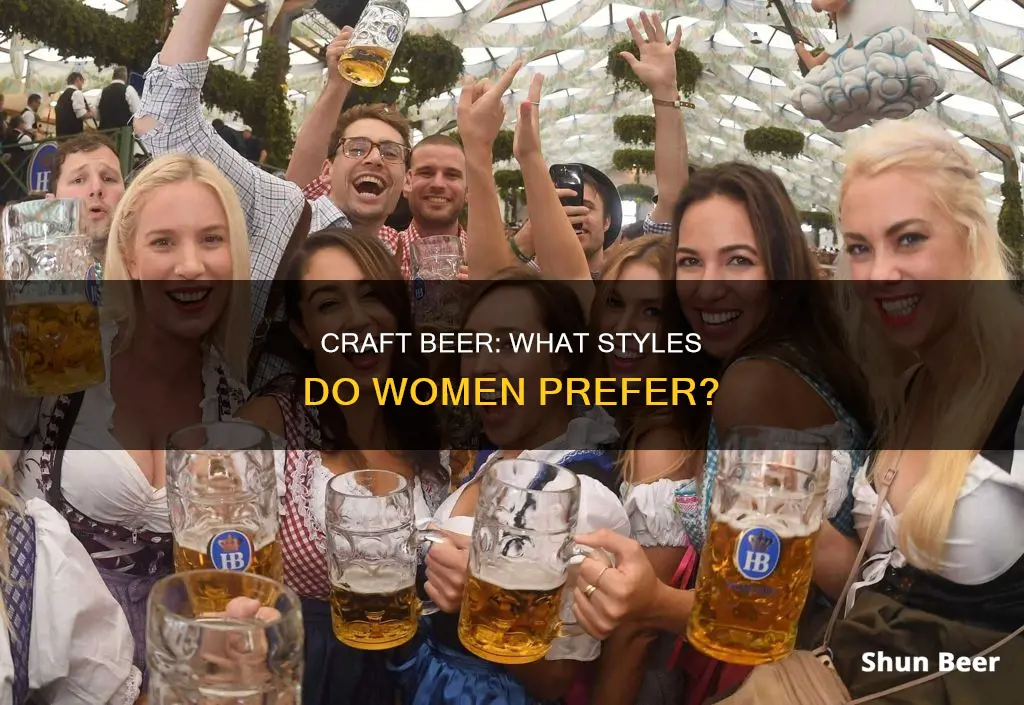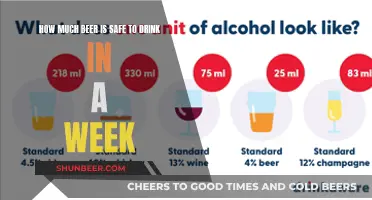
Despite the fact that women have historically been integral to the production and consumption of beer, the beverage has become increasingly associated with masculinity in modern times. This shift can be attributed to various factors, including the transformation of beer from a sustenance drink to a leisure activity, the influence of toxic masculinity and lad culture, and gendered marketing campaigns. As a result, women who drink beer often face stereotypes, judgement, and sexism, with many feeling pressured to conform to gender norms that dictate they should prefer sweeter drinks or wine. However, there is a growing movement of women who are challenging these stereotypes and reclaiming their place in the beer industry, both as consumers and brewers.
| Characteristics | Values |
|---|---|
| Reason for drinking beer | Enjoy the taste, curiosity |
| Reasons for not drinking beer | Fear of judgement, male-oriented advertising, fear of bloating, assumed high calories, gender stereotypes |
| Preferred drinks | Sweeter mixed drinks, wine |
What You'll Learn

Beer advertising and women
Historically, women were integral to the production and consumption of beer. In ancient Mesopotamia, beer was typically brewed by women, and the deity of brewing was a goddess, Ninkasi. The Hymn to Ninkasi served as both a recipe and a ritual, depicting Ninkasi as an active participant in the brewing process. Similarly, in the Middle Ages, women played a crucial role in developing beer recipes. Hildegard von Bingen, a 12th-century visionary and medical practitioner, recognised the preservative qualities of hops in beer. Despite this historical involvement, the presence of women in beer-drinking spaces seemed to decline from the Early Modern period onwards.
The shift towards beer being seen as a "man's drink" can be attributed to the transformation of beer's function and the spaces in which it was consumed. Beer changed from being a source of sustenance to a leisure activity, and with the emergence of "lad" culture, particularly in universities, beer became closely associated with masculinity. Gender roles became more defined, with women expected to remain in the "private sphere" of the home while the "public sphere" of work and leisure was dominated by men. This exclusion of women from beer-drinking spaces was further reinforced by media and advertising portrayals of beer as a masculine drink.
In the 20th century, lager exploded onto the market, and marketing campaigns actively targeted women, utilising "blokish" culture to shape the image of the "new woman". While these campaigns aimed to boost sales and attract women to beer consumption, they often played upon the tension between femininity and beer drinking. Even with women established in drinking spheres, the idea that beer was synonymous with men persisted. This was exacerbated by the focus on diet culture in the 1980s and 1990s, with low-calorie and "cheat day" buzzwords attached to wine and spirits, positioning them as more feminine choices.
Today, women still face stereotypes and judgment when it comes to drinking beer. A report by Dea Latis found that many female drinkers are put off by fears of bloating and marketing campaigns that cater to laddish culture. The report's co-author, Annabel Smith, emphasised that women do not want a "beer made for women" but rather for the industry to reconsider how beer is presented and positioned to female consumers. This includes offering women the chance to taste different beers without committing to a full pint or half-pint, as well as moving away from associations with bloating and high calories.
To conclude, beer advertising and women have a complex and evolving relationship. While historical evidence suggests that women were once central to the world of beer, social and cultural changes have led to beer being closely associated with masculinity in modern times. This has been influenced and reinforced by advertising and media portrayals, which have contributed to the gender divide in beer consumption. However, there are signs of a shift, with women increasingly challenging stereotypes and calling for the beer industry to reconsider its image and marketing approaches to appeal to female drinkers.
Beer and Medifast: What You Need to Know
You may want to see also

Beer's image problem
Beers Image Problem
Beer has long been associated with men and "lad culture", and this is off-putting to many women. In popular culture, beer is often shown as being off-limits to women, and this is reflected in the real world, where women are frequently assumed to prefer wine or cocktails by waiting staff. This is despite the fact that women have historically been integral to the production and consumption of beer.
The image problem is twofold: firstly, beer is seen as a masculine drink, and secondly, beer is associated with negative aspects of masculinity, such as toxic behaviour, football hooliganism, and beer bellies. This means that women who drink beer are often seen as "one of the boys" or "pick-me girls", and may be judged for their choice of drink. This is particularly true in the UK, where beer is integral to "lad culture", especially at university.
The problem is perpetuated by beer advertising, which tends to be "laddish" and male-oriented, and by the design of beer packaging, which often features bold colours and animal motifs. This gives beer a blokish image that does not appeal to women. It also doesn't help that beer is often high in calories, and associated with bloating, which puts off many women.
The result is that many women feel they need to justify their choice of drink, or that they have to dress or behave in a certain way to be seen as acceptable when drinking beer. This is despite the fact that, in a survey, over half of the women asked admitted to enjoying the taste of beer. It is clear that the beer industry needs to do more to appeal to women and to move away from outdated stereotypes.
Copper Mugs and Beer: Safe or Not?
You may want to see also

Women in beer production
While beer is often deemed a <'man's drink' in popular culture, women have been integral to the production and consumption of brewing and drinking. In ancient Mesopotamia, beer was typically brewed by women and was key to maintaining sustenance within the population. Women also owned taverns, and the deity of brewing in Mesopotamia's polytheistic society was a goddess. In the Middle Ages, women were at the forefront of pioneering and developing beer recipes, and the figure of the alewife emerged, attracting business to taverns.
However, the shift from beer as a source of sustenance to an element of leisure, alongside the emergence of diet culture and university life, contributed to the exclusion of women from beer-drinking spaces. The rise of 'lad' culture, gendered marketing, and stereotypes about women's drinking preferences further reinforced the perception of beer as off-limits for women.
Today, women in the beer industry continue to challenge these stereotypes and gendered assumptions. Female brewers, such as Jaega Wise, head brewer for Wild Card Brewing in Walthamstow, London, are speaking out about the need for the beer industry to overcome outdated stereotypes and gendered marketing. Emmie Harrison-West, a freelance journalist and beer enthusiast, started an Instagram page (@beerwomxn) to combat stereotypes and showcase the talent of women in craft beer.
Despite these efforts, gendered assumptions about drinking preferences persist, and women who drink beer often face judgement and stereotyping. Women who choose to drink beer may be seen as 'pick-me girls' or 'one of the boys', highlighting the complex dynamics between gender and drinking culture.
Exploring Hippie Beer Choices: What's Their Brew?
You may want to see also

Beer drinking in social settings
This assumption is reinforced by advertising and popular culture, which often depict men drinking beer and women drinking other types of alcohol. For example, a survey found that 27% of women are put off by "male-oriented" advertising, and 17% are afraid of being judged for drinking beer. This can lead to a self-fulfilling prophecy, where women avoid drinking beer because they believe it is not socially acceptable for them to do so, and the beer industry continues to market primarily to men because they believe women are not interested in their product.
The association of beer with masculinity can also lead to a form of gendered gatekeeping, where men may try to discourage women from drinking beer or may find it unusual or "cool" when a woman does drink beer. This can create a complex dynamic in social settings, where women who drink beer may feel like they are being judged or fetishised, while men who drink beer may feel like they are reinforcing traditional gender roles or excluding women.
However, it is important to note that these gender stereotypes are not universally true, and there are women who enjoy drinking beer and men who prefer other types of alcohol. There are also efforts to challenge these stereotypes and encourage women to drink beer, such as the beer Instagram page @beerwomxn, which was set up to combat outdated and ignorant assumptions about women and beer.
Beer and Prozac: What You Need to Know
You may want to see also

Beer and calories
While there are no gender-based biological factors that determine one's taste preferences, societal stereotypes and expectations often result in women being discouraged from drinking beer. A survey found that while over half of the women asked enjoyed the taste of beer, 27% were put off by 'male-oriented' advertising, and 17% avoided it due to fear of judgement.
Regardless of gender, if you're watching your weight, it's important to be mindful of the calories in your drink. Beer is made from fermented grain, and its calories come mainly from carbs and alcohol. The calorie content of beer varies depending on the maker and type, but it typically contains around 150 calories per 12-ounce serving. Light beers have fewer calories, ranging from 50 to 100 calories per serving. Non-alcoholic beers are another low-calorie option, typically containing fewer than 0.5% ABV.
Compared to wine or spirits, beer tends to be higher in calories. For example, a 12-ounce bottle of Heineken has about 149 calories, while Budweiser has 145 calories. Lighter beers, such as Coors Light and Miller Lite, have fewer calories, with 102 and 96 calories, respectively. The number of calories in beer is influenced primarily by its alcohol content, with higher-alcohol beers tending to be more calorie-dense.
If you're looking to cut down on calories, there are a few strategies you can employ. Firstly, opt for light beers or non-alcoholic alternatives. Additionally, drinking a glass of water between alcoholic beverages and using a pre-measured cup can help you keep track of your intake and avoid overindulging. Adding fruit to your beer can also give you a kick of nutrients. Remember, the recommended daily limit is one serving of alcohol for women and two servings for men.
Leftover Beer: Safe to Drink or Not?
You may want to see also
Frequently asked questions
There is no biological reason why women wouldn't like beer. However, societal stereotypes and expectations, as well as male-oriented advertising, have contributed to the idea that beer is a "man's drink".
Women are often served wine, spirits, or cider instead of beer and are made to feel like they will be judged for drinking beer. They are also put off by fears of bloating and the assumption that beer is high in calories.
Women don't want a "beer for women". They want the beer industry to reconsider how beer is presented and positioned to them. They also want to be offered the chance to taste different beers without having to commit to a full pint or half-pint.







